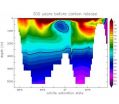INFORMATION:
This research was undertaken with the assistance of resources from the National Computational Infrastructure (NCI), which is supported by the Australian Government.
Solution to corrosive ocean mystery reveals future climate
Researchers discover cause of PETM corrosive ocean event, revealing important ramifications for climate's sensitivity to CO2
2015-05-12
(Press-News.org) Around 55 million years ago, an abrupt global warming event triggered a highly corrosive deep-water current to flow through the North Atlantic Ocean. The origin of this corrosive water has puzzled scientists for a decade.
Now, researchers have discovered this current and how it formed. The findings, published today in Nature Geoscience, also have profound implications for the sensitivity of our current climate to carbon dioxide emissions.
The researchers explored the acidification of the ocean that occurred during a period known as the Paleocene Eocene Thermal Maximum (PETM) when the Earth warmed 5°C in response to a rapid rise in CO2 in the atmosphere and one of the largest mass extinctions occurred in the deep ocean.
This period is considered to closely resemble the scenario of global warming we are experiencing today.
"There has been a longstanding mystery about why ocean acidification caused by rising atmospheric CO2 during the PETM was so much worse in the Atlantic compared to the rest of the world's oceans," said lead author from the ARC Centre of Excellence for Climate System Science, Ms Kaitlin Alexander.
"Our research suggests the shape of the ocean basins and changes to ocean currents played a key role in this difference. Understanding how this event occurred may help other researchers to better estimate the sensitivity of our climate to increasing CO2."
To get their results the researchers recreated the ocean basins and land masses of 55 million years ago in a global climate model.
At this time there was a ridge on the ocean floor between the North and South Atlantic that separated the deep water in the North Atlantic from the rest of the world's oceans. It has been described as being like a giant bathtub on the ocean floor.
The simulations showed this "bathtub" in the North Atlantic became filled with extremely corrosive water that came from the Arctic Ocean, mixed with dense salty water from the Tethys Ocean and sank to the North Atlantic seafloor where it accumulated. The sediment in this area indicates the water was so corrosive that it dissolved all the calcium carbonate produced by organisms that settled on the ocean floor.
When the Earth warmed as a result of a rapid increase in atmospheric CO2, it eventually warmed this corrosive bottom water. As this corrosive water warmed it became less dense and was replaced by denser water sinking from above.
The corrosive deep water was pushed up and spilled over the edge of the giant "bathtub" and flowed down into the South Atlantic.
"That corrosive deep water spread south through the Atlantic, then east into the Southern Ocean and eventually made its way to the Pacific," said co-author Prof Tim Bralower from the Department of Geosciences at Pennsylvania State University.
"The pattern of the event corresponds very closely to what the sediment records tell us, which show almost 100% dissolution of calcium carbonate in the South Atlantic sediment."
Determining how the event occurred also has important implications for today's climate and how it might warm in response to increases in atmospheric CO2.
This is because if the high amount of acidification in the Atlantic Ocean was an indication of global acidification, then it would suggest enormous amounts of CO2 are necessary to increase temperatures by 5°C.
However, these latest findings suggest that other factors made the Atlantic bottom water more corrosive than in other ocean basins.
"We now understand why the dissolution of sediments in the Atlantic Ocean was different from records in other ocean basins," said fellow author of the paper Associate Professor Katrin Meissner from the Climate Change Research Centre at the University of New South Wales.
"Using all sediments combined we can now estimate that the amount of greenhouse gases released into the atmosphere causing a temperature rise of 5°C was around the CO2 equivalent of 7,000 - 10,000 gigatons of carbon. This is similar to the amount of carbon available in fossil fuel reservoirs today."
The big difference between the PETM and the alteration to the current climate is the speed of the change, said lead author Kaitlin Alexander.
"Today we are emitting CO2 into the atmosphere ten times faster than the rate of natural CO2 emissions during the PETM," Ms Alexander said.
"If we continue as we are, we will see the same temperature increase that took a few thousand years during the PETM occur in just a few hundred years. This is an order of magnitude faster and likely to have profound impacts on the climate system."
ELSE PRESS RELEASES FROM THIS DATE:
A fine-tuned approach improves platelet generation from stem cells
2015-05-11
A low platelet count can occur as the result of a variety of medical conditions and as a medication side effect. Platelet transfusion is often required for individuals with a critically low platelet level. Currently, the primary source of platelets is volunteer donors. Unfortunately, donated platelets have an extremely short shelf life and can be in limited supply. A new study in the Journal of Clinical Investigation reports on a method to generate progenitor cells from murine embryonic stems that are able to produce a large number of functional platelets. Mitchell Weiss ...
Group B Streptococcus breaches the blood-brain-barrier
2015-05-11
Bacterial meningitis is a life-threating infection of the central nervous system. Group B Streptococcus (GBS) is the leading cause of meningitis in newborn babies and can cause severe complications in those that survive the infection. GBS must cross the blood-brain-barrier (BBB) to cause disease but it is not clear how these organisms breach this barrier. A new study in the Journal of Clinical Investigation identifies a pathway that is induced by GBS and disrupts junctions between cells. Kelly Doran and colleagues at San Diego State University determined that GBS induces ...
Vineyard habitats help butterflies return
2015-05-11
PROSSER, Wash. - Washington wine grape vineyards experimenting with sustainable pest management systems are seeing an unexpected benefit: an increase in butterflies.
Over the years, loss in natural habitat has seen the decline in numbers of around 50 species of butterflies in eastern Washington. But in a recent Washington State University study published in the June issue of the Journal of Insect Conservation, researchers found that vineyards that create nearby natural habitats have three times the number of butterfly species and four times more butterflies than conventional ...
An important step in artificial intelligence
2015-05-11
In what marks a significant step forward for artificial intelligence, researchers at UC Santa Barbara have demonstrated the functionality of a simple artificial neural circuit. For the first time, a circuit of about 100 artificial synapses was proved to perform a simple version of a typical human task: image classification.
"It's a small, but important step," said Dmitri Strukov, a professor of electrical and computer engineering. With time and further progress, the circuitry may eventually be expanded and scaled to approach something like the human brain's, which has ...
Certain immigrants, refugees at higher risk of psychotic disorders
2015-05-11
TORONTO (May 11, 2015) -- Immigrants from the Caribbean and Bermuda, as well as refugees from East Africa and South Asia, have a 1.5 to 2 times higher risk of psychotic disorders compared to the general population of Ontario, Canada, according to a new study by researchers at the Institute for Clinical Evaluative Sciences (ICES) and the Centre for Addiction and Mental Health (CAMH). The study also found that immigrants from Northern Europe, Southern Europe and East Asia had about half the risk of psychotic disorders compared to the general population.
The study published ...
High-performance 3-D microbattery suitable for large-scale on-chip integration
2015-05-11
By combining 3D holographic lithography and 2D photolithography, researchers from the University of Illinois at Urbana-Champaign have demonstrated a high-performance 3D microbattery suitable for large-scale on-chip integration with microelectronic devices.
"This 3D microbattery has exceptional performance and scalability, and we think it will be of importance for many applications," explained Paul Braun, a professor of materials science and engineering at Illinois. "Micro-scale devices typically utilize power supplied off-chip because of difficulties in miniaturizing ...
Congress approval rating tanking over poor choice of words
2015-05-11
U.S. Congress approval ratings are at record lows. Now a new study suggests that this may be partly due to a decline in the use of warm, agreeable language in the House.
The study, co-authored by University of British Columbia business professor Karl Aquino, found that the use of prosocial words -- language such as cooperate or contribute -- by lawmakers predicts public approval of Congress six months later.
"If members of Congress want to be viewed more positively by the public, it appears that the words they use matter," says Aquino, a marketing and behavioural science ...
Study: World population-food supply balance is becoming increasingly unstable
2015-05-11
Researchers report that as the world population increases and food demand has grown, globalization of trade has made the food supply more sensitive to environmental and market fluctuations. This leads to greater chances of food crises, particularly in nations where land and water resources are scarce and therefore food security strongly relies on imports.
The study assesses the food supply available to more than 140 nations (with populations greater than 1 million) and demonstrates that food security is becoming increasingly susceptible to perturbations in demographic ...
Childhood cancer treatment and age influence obesity risk for childhood cancer survivors
2015-05-11
(MEMPHIS, Tenn. - May 11, 2015) Childhood cancer survivors - especially those whose treatment included brain irradiation or chemotherapy with glucocorticoids - are 14 percent more likely to be obese than their healthy peers. The St. Jude Children's Research Hospital study appears today in the journal Cancer.
Of the 1,996 childhood cancer survivors in this study, 36.2 percent had a body mass index (BMI) of 30 kilograms per meters squared or more, which qualifies as obese. That was 14 percent greater than the expected prevalence based on federal health survey data of a ...
First cancer-promoting oncogenes discovered in rare brain tumor of children and adults
2015-05-11
(MEMPHIS, Tenn. - May 11, 2015) Researchers have identified three genes that play a pivotal role in the brain tumor choroid plexus carcinoma (CPC), a discovery that lays the groundwork for more effective treatment of this rare, often fatal cancer. St. Jude Children's Research Hospital scientists led the study, which appears today in the journal Cancer Cell.
The genes - TAF12, NFYC and RAD54L - are involved in DNA repair and regulation. Researchers showed that CPC often has at least one extra copy of each gene and demonstrated that the genes work cooperatively to launch ...
LAST 30 PRESS RELEASES:
Scientists use ultrasound to soften and treat cancer tumors without damaging healthy tissue
Community swimming program for Black youth boosts skills, sense of belonging, study finds
Specific depressive symptoms in midlife linked to increased dementia risk
An ‘illuminating’ design sheds light on cholesterol
Who is more likely to get long COVID?
Study showcases resilience and rapid growth of “living rocks”
Naval Research Lab diver earns Office of Naval Research 2025 Sailor of the Year
New Mayo-led study establishes practical definition for rapidly progressive dementia
Fossil fuel industry’s “climate false solutions” reinforce its power and aggravate environmental injustice
Researchers reveal bias in a widely used measure of algorithm performance
Alcohol causes cancer. A study from IOCB Prague confirms damage to DNA and shows how cells defend against it
Hidden viruses in wastewater treatment may shape public health risks, study finds
Unlock the power of nature: how biomass can transform climate mitigation
Biochar reshapes hidden soil microbes that capture carbon dioxide in farmland
Reducing saturated fat intake shows mortality benefit, but only in high-risk individuals
Manta rays create mobile ecosystems, study finds
Study: Mixed results in using lipoic acid to treat progressive multiple sclerosis
Norbert Holtkamp appointed director of Fermi National Accelerator Laboratory
New agentic AI platform accelerates advanced optics design
Biologists discover neurons use physical signals — not electricity — to stabilize communication
Researchers discover that a hormone can access the brain by hitchhiking
University of Oklahoma researcher awarded funding to pursue AI-powered material design
Exploring how the visual system recovers following injury
Support for parents with infants at pediatric check-ups leads to better reading and math skills in elementary school
Kids’ behavioral health is a growing share of family health costs
Day & night: Cancer disrupts the brain’s natural rhythm
COVID-19 vaccination significantly reduces risk to pregnant women and baby
The role of vaccination in maternal and perinatal outcomes associated with COVID-19 in pregnancy
Mayo Clinic smartwatch system helps parents shorten and defuse children's severe tantrums early
Behavioral health spending spikes to 40% of all children’s health expenditures, nearly doubling in a decade
[Press-News.org] Solution to corrosive ocean mystery reveals future climateResearchers discover cause of PETM corrosive ocean event, revealing important ramifications for climate's sensitivity to CO2



